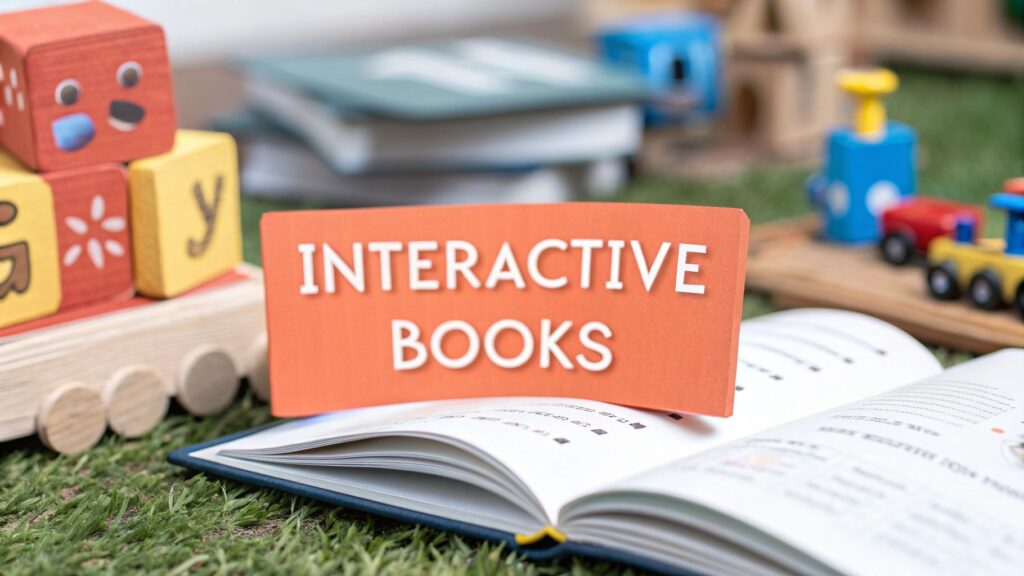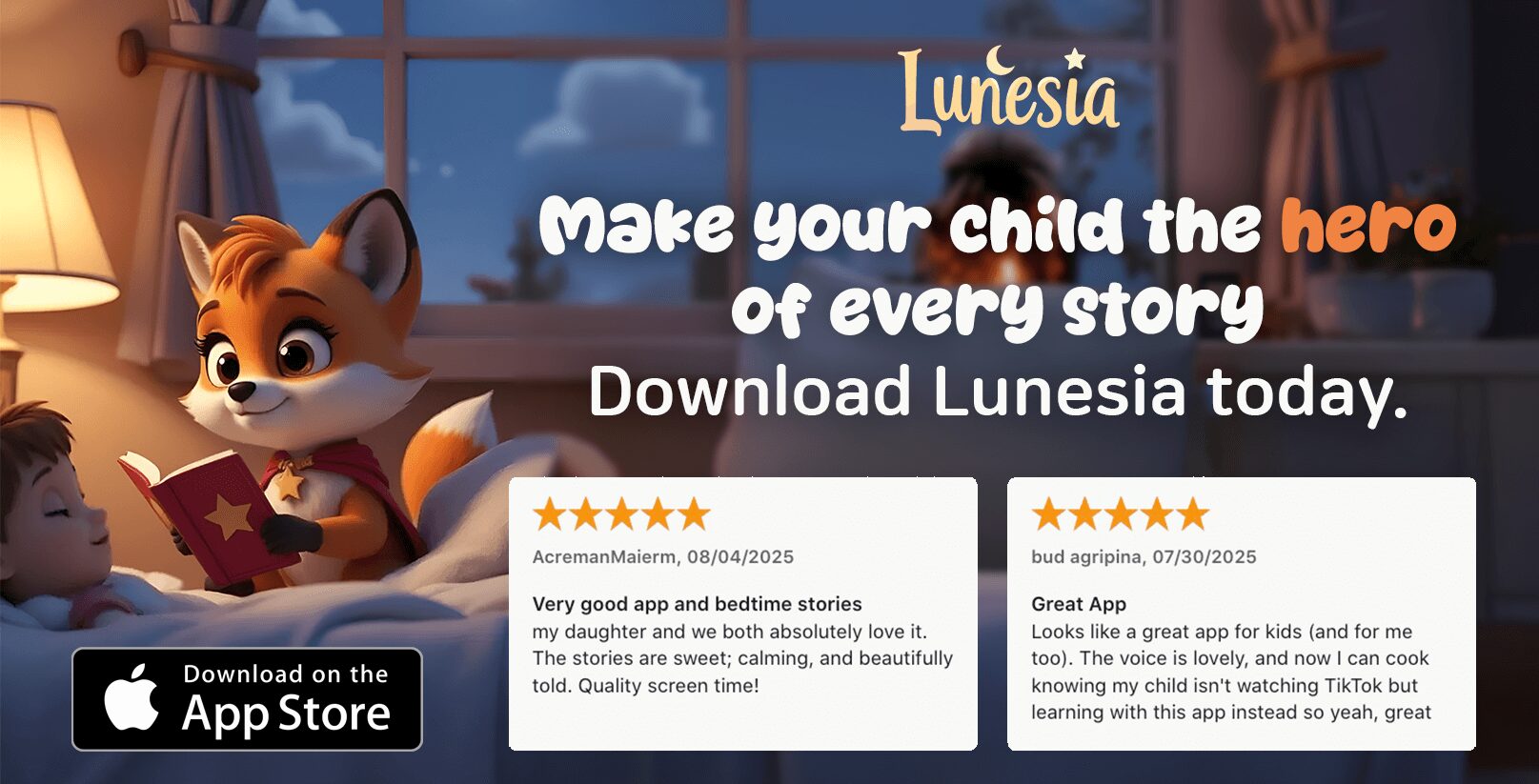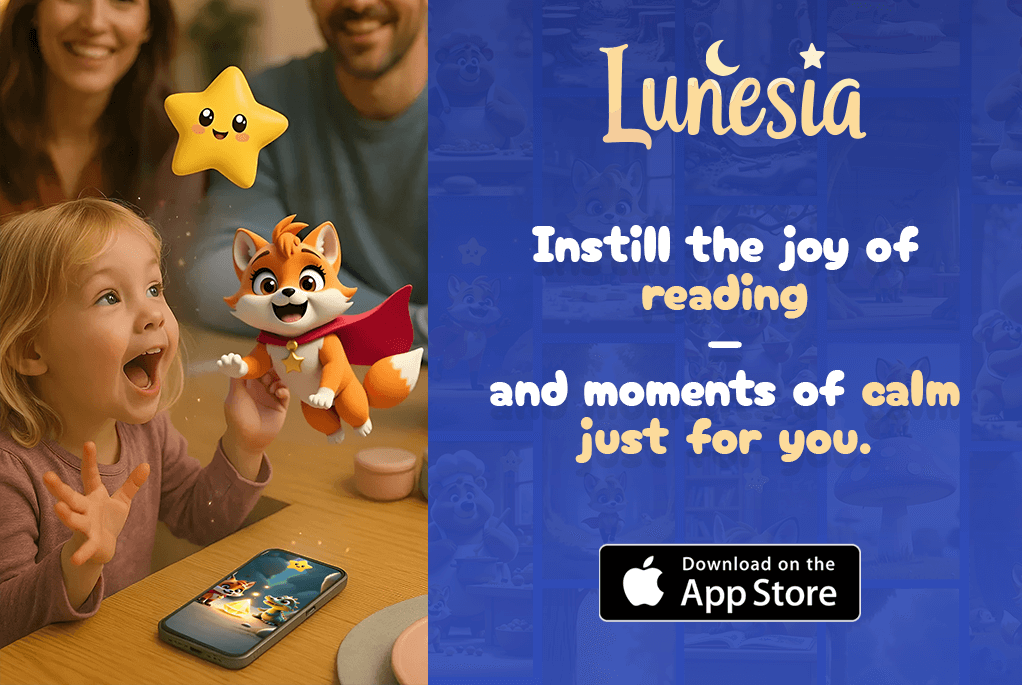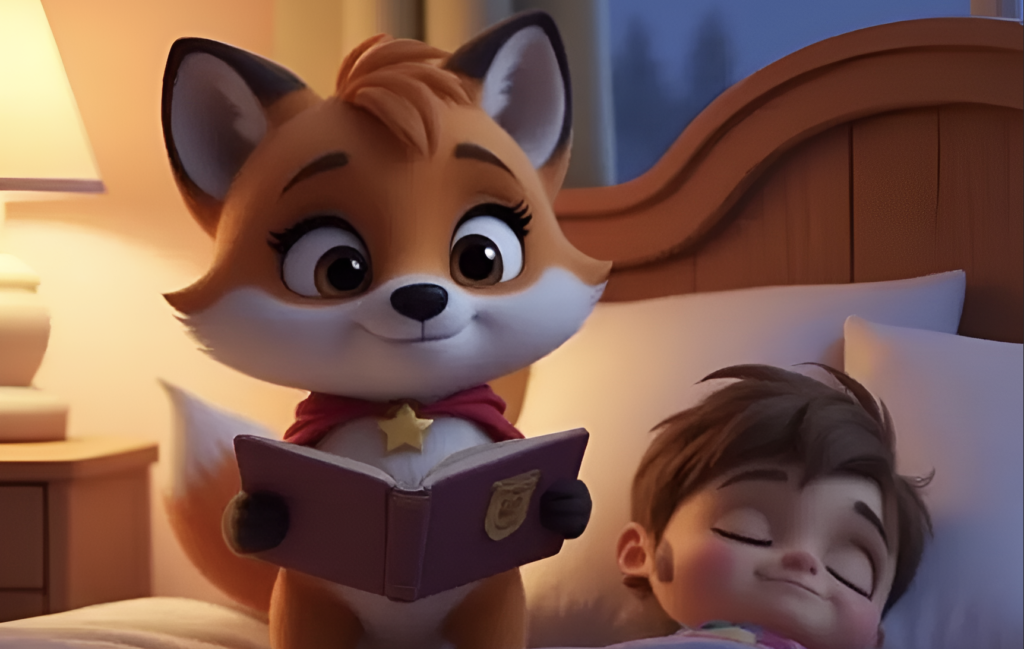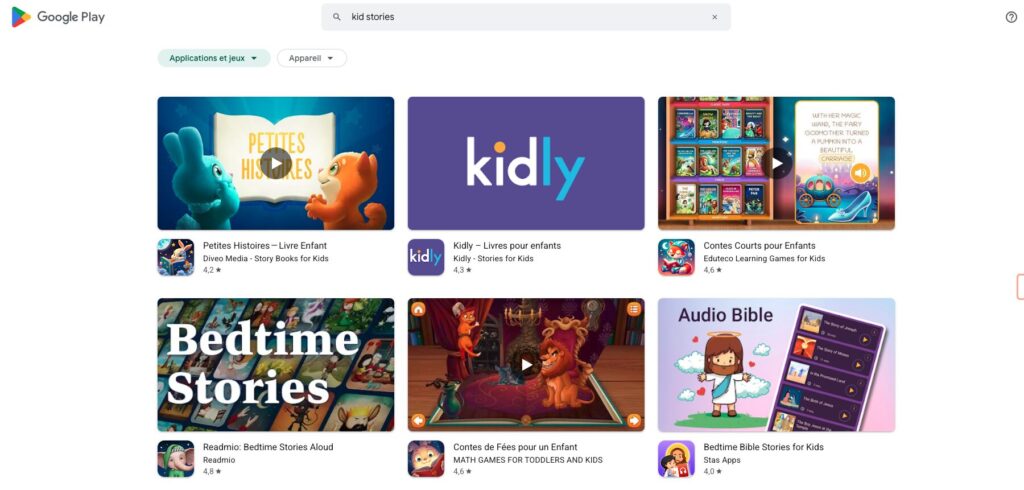Struggling to find the best interactive books for preschoolers that actually hold their attention? You’ve probably tried the classics—and while lift-the-flap books are fantastic, a new wave of storytelling is here to completely change the game. Imagine an app where your child doesn’t just listen to a story, but steps into the hero’s shoes, making decisions that shape the entire adventure. This is where apps like Lunesia are turning story time into an unforgettable journey.
Why Interactive Stories Are a Game-Changer for Preschoolers
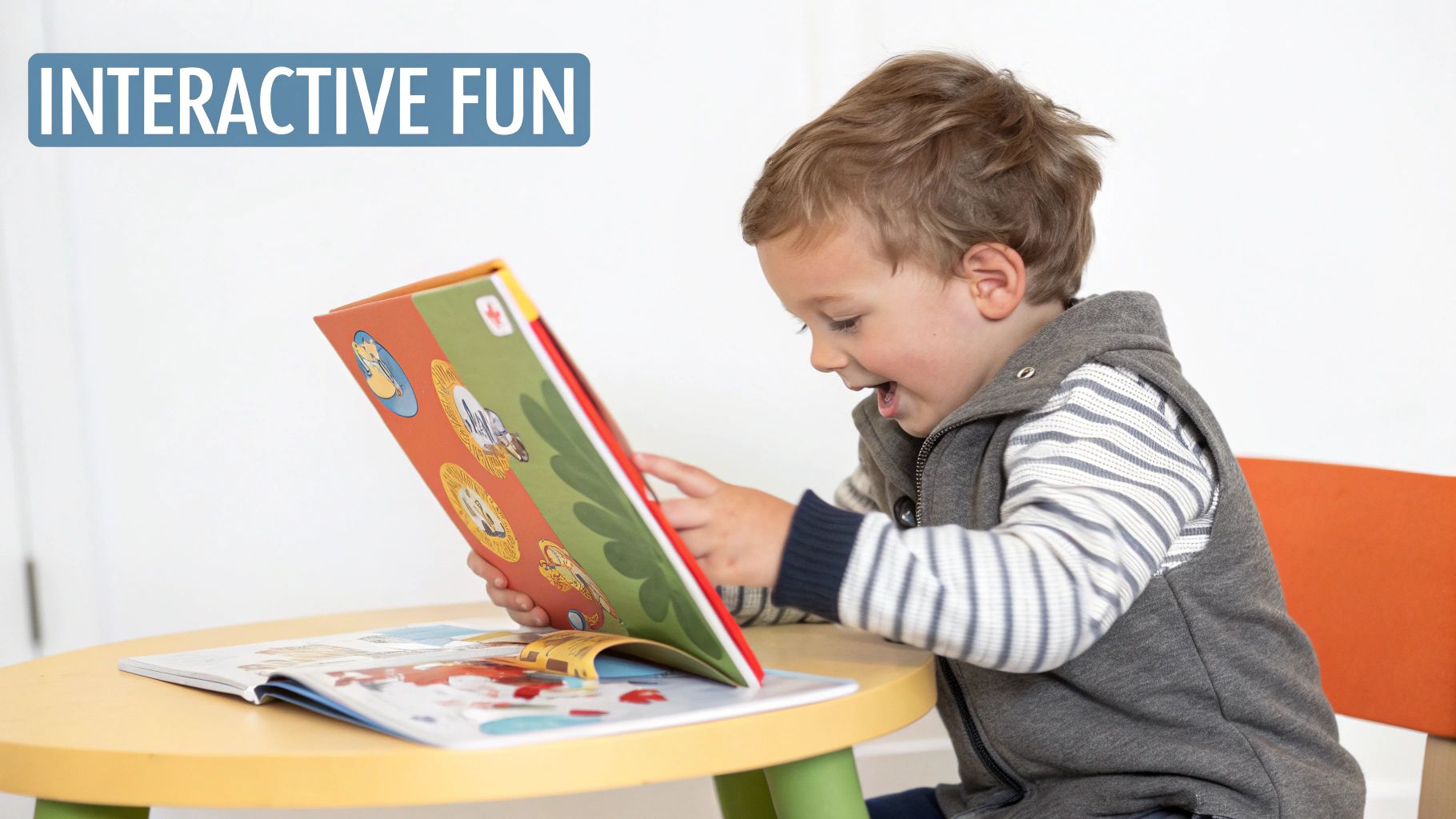
Have you ever settled down for story time, full of hope, only to watch your preschooler’s attention wander off after just two pages? We’ve all been there. It’s frustrating, right? But what if the story itself could pull them back in by asking, "What do you think we should do next?"
That’s the secret power of interactive reading. It bridges the gap between passively listening and actively participating. Instead of just hearing about a character’s challenge, your child gets to help solve it.
From Listener to Fearless Leader
Picture this: your child isn’t just following a brave knight—they’re telling him which path to take. It's their call whether he crosses the wobbly bridge or finds a safer way around. Can you imagine how empowering that feels for a three-year-old? This simple shift turns reading from a one-way lecture into a lively, two-way adventure.
This hands-on approach builds skills that are crucial for navigating daily life:
- Problem-Solving: When faced with a choice, they learn to pause, think, and consider the consequences. Sound familiar? It’s the same skill they need when deciding whether to share a toy.
- Emotional Resilience: Helping a character overcome their fear of the dark gives them a safe space to practice being brave. Suddenly, the monster under their own bed seems a little less scary. According to child psychologists, this "narrative rehearsal" helps children build emotional toolkits for real-life anxieties.
- Confidence: Making choices that matter in a story builds a powerful sense of agency. They learn that their voice has an impact, a foundational lesson for life.
By turning your child into the hero, interactive stories powerfully teach them that their choices matter. This simple lesson is the bedrock of empathy, kindness, and courage—all practiced within a safe, imaginative world.
This is exactly what makes platforms like Lunesia so revolutionary. These aren't just bedtime stories; they're carefully crafted journeys designed to build character. As your child helps a lost star find its way home, they are also learning about perseverance and kindness in a way that truly sticks. The benefits of this kind of interactive storytelling for preschoolers are profound and last long after the screen is off.
What Separates a Good Interactive Book from a Great One?
Ever wonder what makes one interactive book a treasured favorite while another is forgotten after five minutes? It isn’t just about flashy animations or silly sound effects. The best interactive books for preschoolers share a secret ingredient that sparks genuine curiosity and nurtures their rapidly developing minds. It's the difference between a simple distraction and a powerful tool for growth.
A truly great interactive book doesn’t just entertain; it invites your child to become a co-creator of the story. Think of a physical book where lifting a flap reveals a hidden creature. Now, imagine a digital story where their choice determines which creature they meet next. That sense of control is pure magic for a little one.
More Than Just Mindless Tapping
True interactivity is about meaningful choices, not just tapping a screen to see what happens. Does the book ask your child to think, feel, and decide? This is where an app like Lunesia stands apart. Instead of just tapping to trigger an animation, a child might be asked to help a nervous character choose a path through a dark forest.
That simple choice does so much more than advance the plot. It teaches them:
- Empathy: They have to stop and consider how the character feels before making a decision.
- Problem-Solving: They start to connect actions with consequences in a tangible way.
- Courage: By helping a character be brave, they are practicing bravery themselves in a completely safe space.
When children see the direct results of their choices, it builds a foundational understanding of cause and effect. You can discover more about how the right interactive elements in kids' stories can build these crucial life skills.
The right kind of interaction builds a strong foundation across cognitive, language, and even motor domains, as you can see below.
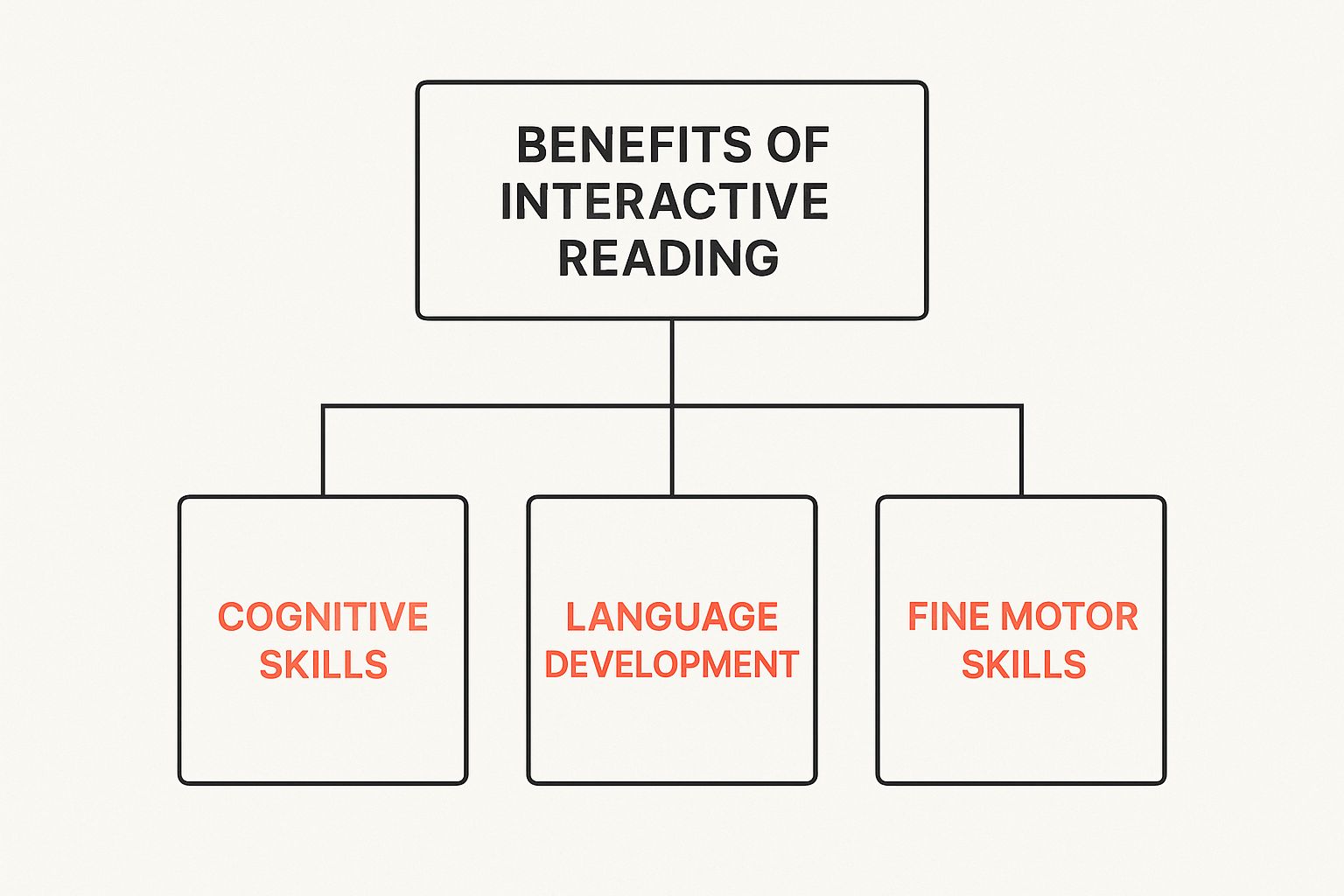
This quick-reference guide shows how different features in both physical and digital books can support your child's development.
Key Features of High-Quality Interactive Books
| Feature | What It Looks Like (Physical Books) | What It Looks Like (Digital Apps) | Developmental Benefit |
|---|---|---|---|
| Choice & Consequence | Simple branching paths ("If you go to the cave, turn to page 10") | Branching storylines where choices change the plot (e.g., Lunesia) | Problem-solving, decision-making |
| Sensory Engagement | Textures to feel, flaps to lift, sounds from embedded buttons | Tapping to trigger animations, sounds, or character dialogue | Fine motor skills, sensory exploration |
| Empathetic Prompts | Asking "How do you think the bear feels?" | Asking the child to help a scared character or make a kind choice | Emotional intelligence, empathy |
| Problem-Solving Tasks | Puzzles to solve (e.g., finding hidden objects on a page) | Mini-games or choices that require logical thinking (e.g., build a bridge) | Critical thinking, logic |
| Repetitive Engagement | Familiar rhymes or phrases the child can repeat on each page | Sound effects or character phrases that can be replayed | Language development, memory retention |
Ultimately, high-quality interactive books, whether on a shelf or a screen, are designed to make a child an active participant, not a passive observer.
The Real Prize: A Parent's Peace of Mind
At the end of the day, what’s the biggest bonus of a great interactive experience? It’s something priceless: guilt-free time for you. Knowing your child is immersed in a safe, ad-free adventure that’s actively building their character allows you to finally sip that coffee while it's still hot. That's the real magic.
How to Find the Perfect Story for Your Unique Child
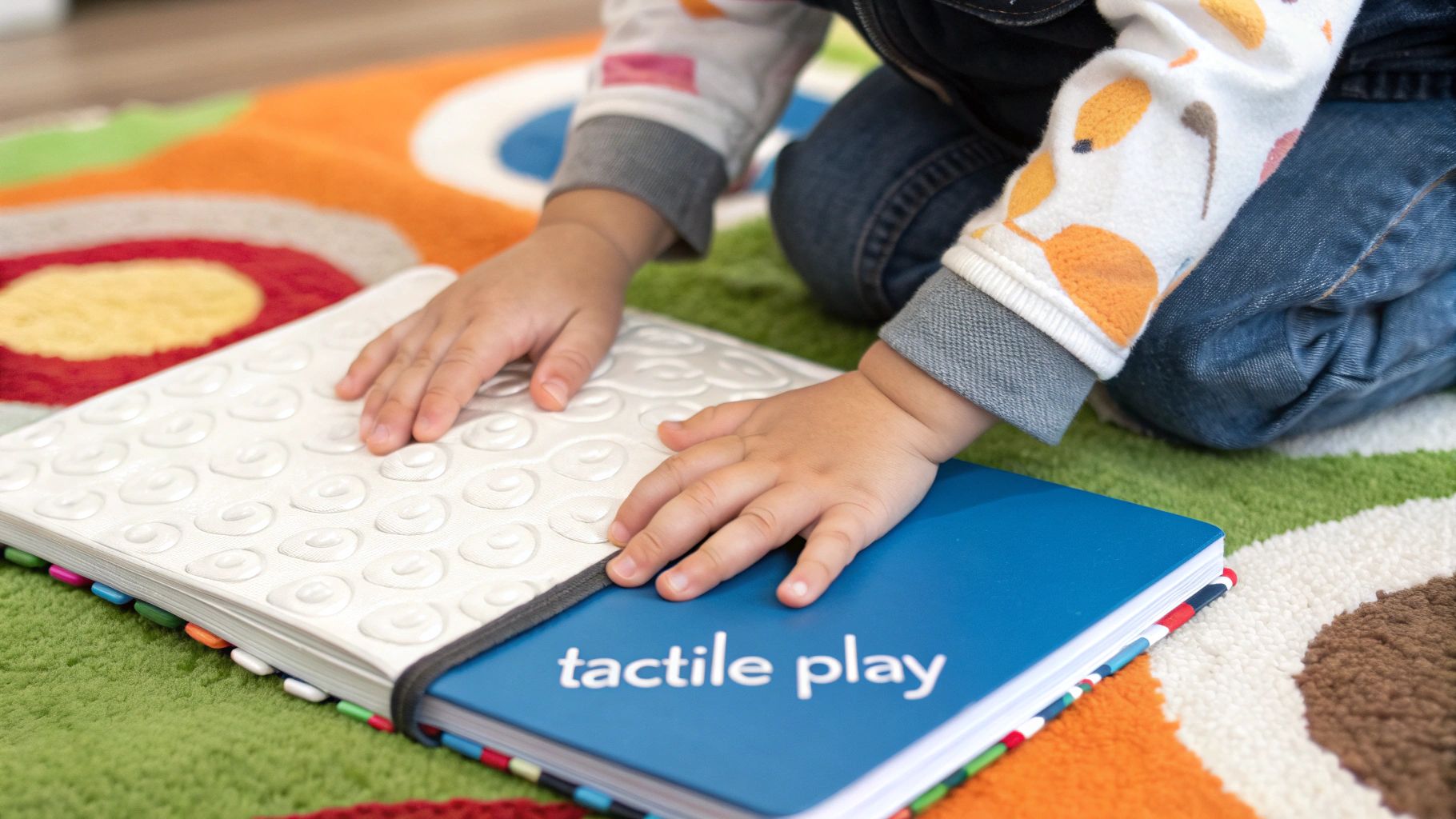
Feeling a little overwhelmed by all the options out there? I get it. From classic pop-up books to a universe of story apps, choosing the best interactive books for preschoolers can feel like you're trying to solve a puzzle with half the pieces missing.
But let me share a secret: the goal isn’t finding the single best book. It’s about finding the right book for your one-of-a-kind child.
After all, the quiet, sensitive soul who loves to nurture will connect with a totally different story than the high-energy explorer who just wants to build things. The magic happens when you match the experience to their innate personality.
Stories for Every Kind of Little Explorer
So, how do you find that perfect fit? Start by thinking about what truly makes your child’s eyes light up.
-
For the Sensory Seeker: Does your child learn by touching everything? Then tactile books are their best friend. Look for different textures, lift-the-flaps, and sliders that give them that wonderful sensory feedback they crave.
-
For the Budding Problem-Solver: If your little one is always figuring out how things work, find stories that give them a job to do. Interactive stories that require them to build a bridge or find a hidden key are brilliant for building logic skills.
-
For the Empathetic Heart: For the child who feels things so deeply, emotional narratives are a powerful tool. This is where a choice-driven story from an app like Lunesia is incredible. A story might ask your child to help a timid character make a brave choice, giving your little one a safe space to practice courage and compassion right alongside them.
By aligning a story with your child's natural inclinations, you're not just reading—you're speaking their language. This turns story time from a passive activity into a personalized growth experience where they feel truly seen and understood.
Matching Stories to Real-Life Challenges
This personalized approach goes way beyond just keeping them entertained. It can be your secret weapon for guiding your child through common daily struggles.
Have a preschooler who just threw a massive tantrum over a broken cookie? A Lunesia story where they help a character manage frustration teaches them emotional regulation in a fun, low-stakes way. They learn to pause and choose a better reaction, a skill that translates directly to the kitchen floor.
And parents are clearly catching on. In fact, sales of interactive and activity-based children's books shot up by an incredible 22% in 2022 alone, showing a huge demand for these kinds of engaging reading experiences. You can explore more data on this powerful market trend.
By choosing stories that resonate with your child, you're giving them a powerful gift. You're showing them that their feelings are valid, their choices matter, and their unique way of seeing the world is something to be celebrated.
From Tantrums to Teamwork: How Stories Build Emotional Muscle
We’ve all been there. The full-blown meltdown in the cereal aisle. The sudden, tearful fear of monsters under the bed. These huge feelings can feel just as overwhelming for us as they do for our little ones. But what if a simple story could become your secret weapon in those tough moments?
Interactive stories are so much more than a way to pass the time; they’re a safe playground for big emotions. When a child gets to make choices for a character and see what happens next, they aren't just playing a game. They're learning one of life's most critical lessons: how to handle what they feel. This is where the best interactive books for preschoolers truly shine.
A Rehearsal for Real Life
I like to think of it as an emotional dress rehearsal. Imagine a story where a character is scared to go down the big slide. Instead of just being told the character was brave, your child gets to make the brave choice for them. They feel that little spark of courage in a fictional world, which makes it so much easier to find their own bravery at the real-life playground.
This is the genius behind apps like Lunesia, which builds its stories around choices that teach kindness, courage, and empathy.
- Practicing Empathy: When a story asks, "Should we share our snack with the sad-looking squirrel?" your child is actively choosing compassion.
- Building Resilience: Helping a character get back up after a fall teaches perseverance without the sting of a real-life tumble.
- Problem-Solving: Figuring out how to help a lost firefly find its way home isn't just a game—it's building critical thinking skills they'll use for their own challenges.
It's not about shielding our kids from difficult feelings. It's about giving them a toolbox to understand and navigate those feelings before they become overwhelming.
What happens in a story doesn't stay in a story. When children rehearse bravery, kindness, and problem-solving through interactive choices, they are building emotional muscle memory for the real world.
Turning Story Time into Talking Time
These stories are the perfect conversation starters. After an adventure where your child helped a character overcome their fear of the dark, you have a natural way in. You can gently ask, "You were so brave helping Leo the lion! Does anything ever make you feel a little scared at night?"
Suddenly, you’re not just reading a story; you’re connecting on a much deeper level. And while your child is completely absorbed in a meaningful adventure—learning to be a good friend or a brave explorer—you get a moment of peace. That precious, guilt-free time for yourself is a massive bonus, especially when you know they are in a safe, ad-free space that’s actively helping them grow. It’s a win for them, and let's be honest, a much-needed win for you.
How to Finally Achieve Guilt-Free Screen Time
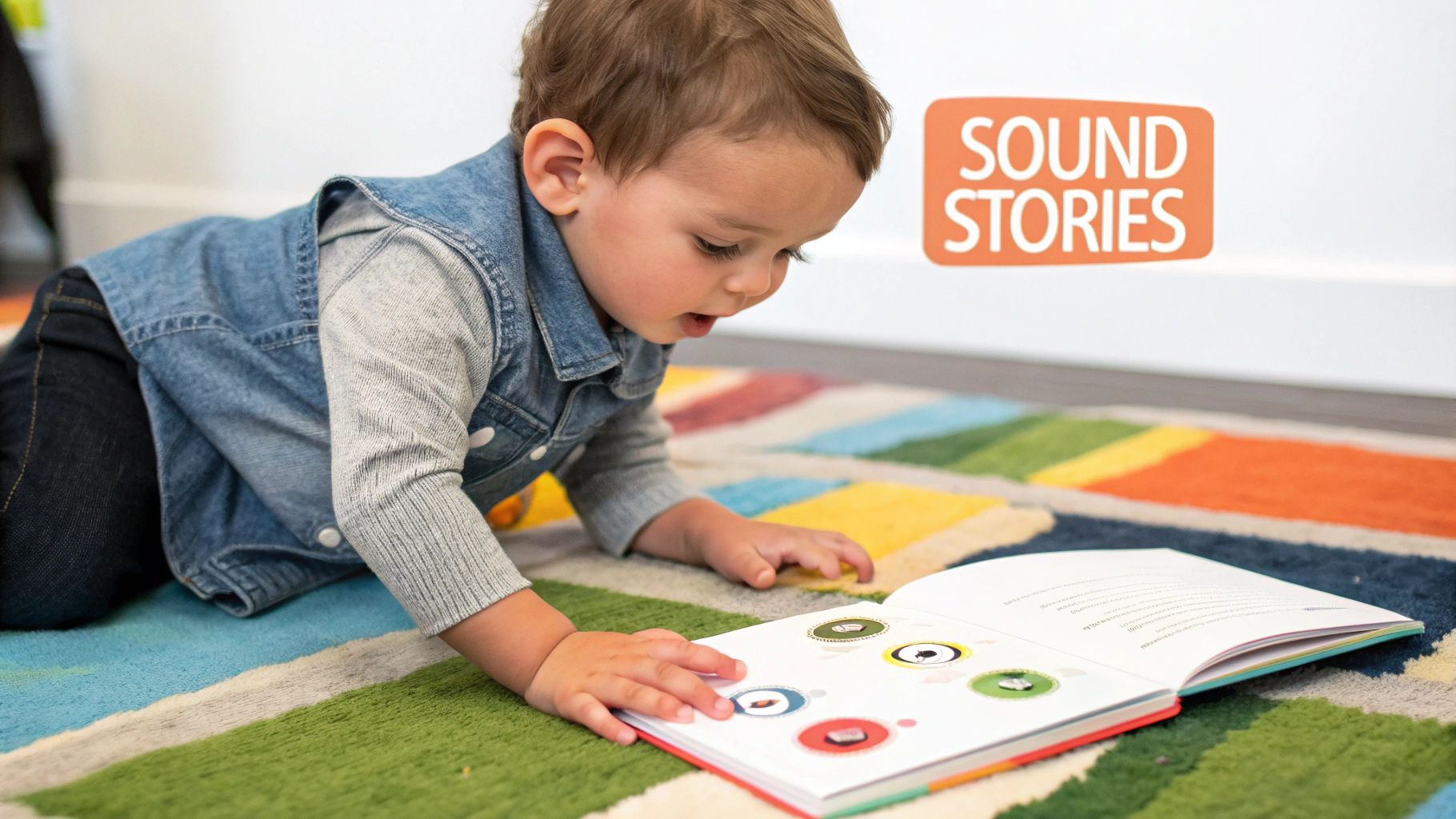
Let's be real for a moment. Every single parent needs a break. But does that familiar wave of guilt wash over you the second you hand your child a screen?
What if you could reclaim 20 minutes of your day, knowing your child wasn't just being distracted, but was actually learning, growing, and completely safe? I'm here to tell you it's not a fantasy—it's entirely possible.
It’s time to stop thinking about the quantity of screen time and start focusing on the quality. The right digital experience isn't about passively zoning out to cartoons; it’s an active, engaging adventure that builds real-world skills.
From Digital Babysitter to Developmental Partner
Think of it this way: what if screen time could be just as enriching as building with blocks or snuggling up with a book? With the right tools, it absolutely can be. In fact, research shows that well-designed educational apps can significantly improve early literacy skills, with some studies showing vocabulary gains of up to 31% in preschoolers.
This is where an app like Lunesia changes the game. It provides a meaningful, totally ad-free, and secure space where kids get lost in value-rich journeys. While they're busy helping a character solve a puzzle, they’re developing critical thinking and emotional intelligence without even realizing it.
Guilt-free screen time isn't about finding a better distraction; it's about finding a powerful educational partner. It's knowing your child is engaged in an activity that nurtures their mind and spirit while you get the precious time you need to recharge.
And you? You finally get that moment to sip your coffee while it's still hot, fire off that important email, or simply breathe. There’s no guilt, only the confidence that your child is in a safe space, learning priceless lessons about kindness, courage, and problem-solving. It’s a healthy balance that gives both of you exactly what you need. You can read more about achieving guilt-free screen time with Lunesia in our dedicated guide.
Of course, to make screen time truly worry-free, it's also smart to think about your child's visual health. It never hurts to check out some expert tips on preventing computer eye strain to create the best possible digital setup for your little one.
Your Top Questions, Answered
Still have a few questions swirling? You’re not alone. When you're trying to find the best interactive books for preschoolers, every parent wants to feel confident they're making the right choice. Let's pour a fresh cup of coffee and get you some clear, straightforward answers.
At what age should I start with interactive books?
I get this one a lot. The great news is there’s a perfect interactive book for just about every stage. You can start with simple, sensory-rich board books—think touch-and-feel textures or lift-the-flap surprises—as early as six to twelve months. These are fantastic for building fine motor skills and teaching that books are a hands-on experience.
For more complex digital stories, like the choice-driven adventures in Lunesia, the preschool years (ages 3-5) are the absolute sweet spot. A child’s brain at this age is perfectly primed to grasp cause and effect. When they see their own decision directly change where the story goes, it’s an incredibly powerful way to teach problem-solving, empathy, and emotional regulation.
Will digital books replace our nightly reading routine?
This is a big one, and I want to be crystal clear: absolutely not. Think of digital stories as an exciting new ingredient in your child's "reading diet," not a replacement for the main course.
Cuddling up with a physical book is irreplaceable for parent-child bonding and foundational literacy skills. You just can't replace the feeling of turning a crisp page together.
Digital interactive books offer a different, but equally valuable, experience. They excel at teaching modern skills like agency, critical thinking, and seeing the world from someone else's perspective. A healthy reading routine can easily include both—a classic paperback at bedtime and a Lunesia adventure during that tricky late-afternoon quiet time.
How do I know if a story app is actually safe?
This is the most critical question. How can you be sure an app is a safe harbor and not just another source of digital noise? It comes down to looking for a few non-negotiable features.
Your safety checklist should always include these:
- A Strict No-Ad Policy: Your child should never be one accidental click away from an advertisement. Period.
- Expert-Crafted Content: Look for stories created with input from child development experts or educators.
- A Secure, Closed Environment: The app must be a self-contained world, free from pop-ups, in-app purchases pitched to kids, or links to social media.
This is precisely why we built Lunesia on these core principles. It's a completely safe, walled garden designed to ensure your child is only exposed to positive, value-rich content. Always take a moment to review an app’s privacy policy before letting your child dive in.
What if my child gets overstimulated by all the features?
It’s a completely valid fear. We’ve all seen those apps so flashy and noisy they seem to agitate kids more than they engage them. But the best experiences are intentionally designed to be calming, not chaotic.
You'll want to look for apps where the sounds and animations serve the story, rather than constantly interrupting it. If you notice your child getting wired or overwhelmed, the app might just be too "busy" for their developing nervous system. Curated platforms like Lunesia are carefully crafted to be engaging yet gentle, using soft animations and soothing narration to draw your child into the story without overwhelming them. It’s all about finding that perfect balance between wonder and calm.
Ready to transform story time into a meaningful adventure that makes a real difference in your daily life? With Lunesia, your child becomes the hero of their own tale, making choices that build courage, kindness, and empathy. Give your child a safe, ad-free world of stories that grow with them, and give yourself the gift of guilt-free peace of mind.
